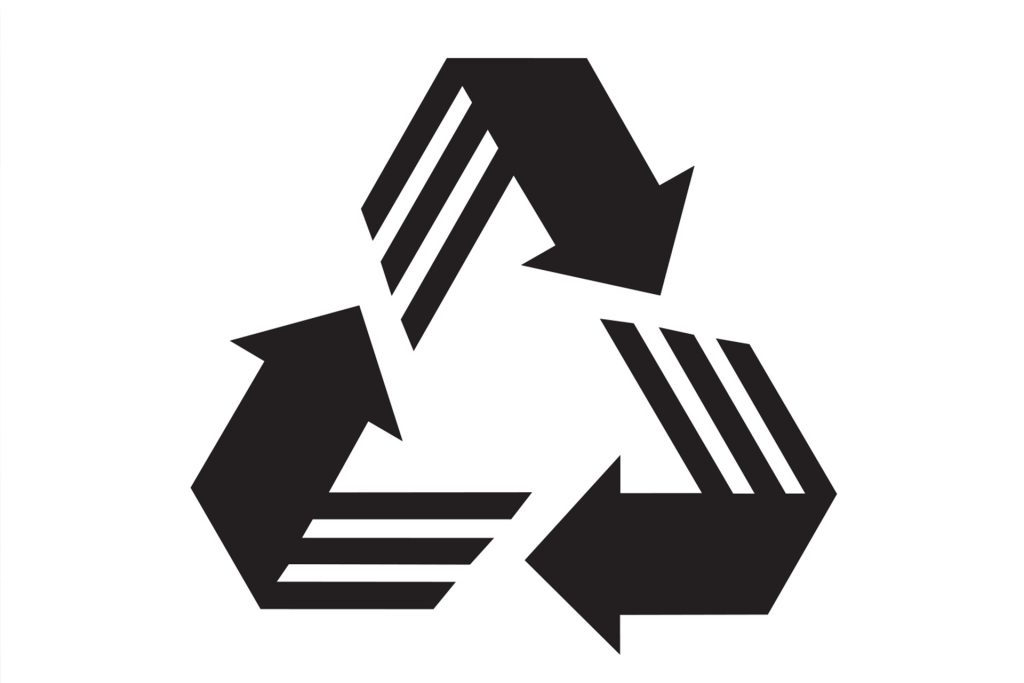We’re all familiar with the recycling loop, the three bent arrows that form a circle. It’s what’s known as the Modius Loop, and is the universally recognised symbol for recycling that first appeared in 1970 – initially to raise consumer awareness of recycled paper.

Fast forward to 1988 and another, very similar logo appeared – a triangle with the numbers 1 to 7 in the middle. You know that one too I’m sure. This is actually the plastic resin identification code and it actually indicates the resin composition of the plastic. The number tells us what type of plastic the container is made from. It was first developed to help recyclers know which plastic a product or packaging was made from so they could determine its recyclability. This is known as a Resin Identification Code (RIC).
Confusing? Yes it certainly is.
The similarity between the recycling symbol and the plastics identification symbols have made it hard for consumers to know what to put in which bin for a long time. Sometimes the plastic type correlates with whether its recyclable, but not always. Recyclability can also depend on other things like the shape of the container as well.
To make the process easier a new recyclability label was developed in 2018 for both Australia and New Zealand. The ARL (Australasian Recycling Label) is an on-pack labelling scheme which helps consumers understand how to recycle products correctly. Shown below, you can see the label really makes it easier to understand which component goes into which bin.
More about the plastics identification codes
Each number within the triangle represents a type of plastic, and different types of plastics are generally used in particular ways, as follows:
Plastic Code #1
RIC 1 indicates that the plastic used is polyethylene terephthalate, which can be shortened to PET or PETE. It is the easiest plastic to recycle, and is normally found on bottles for soft drinks and water, vegetable oil containers and mouthwash bottles.
PET bottles can also be recycled into new containers, pallet straps, panelling, carpet and clothing fibres, and fibrefill for soft furnishings and sleeping bags. When this occurs it becomes known as recycled polyethylene terephthalate (rPET).
Plastic Code #2
RIC 2 refers to a high-density polyethylene, also known as HDPE, is also easily recycled. You can find HDPE in shampoo bottles, butter tubs, shopping bags, bags inside cereal boxes, household cleaner and detergent bottles.
HDPE plastic can be recycled into timber, drainage pipes, pens, fencing, picnic tables, benches and floor tiles, plus back into more bags and bottles.
Plastic Code #3
RIC 3 indicates the plastic is polyvinyl chloride. You can find it in piping, medical equipment, wire jacketing, certain clear food packaging, cooking oil, window cleaner, detergent and shampoo bottles.
Vinyl is rarely recycled. A tiny percentage of PVC is recycled into mats, speed bumps, cables, flooring, roadway gutters, mud flaps, panelling and decks.
Plastic Code #4
RIC 4 is a low-density polyethylene, or LDPE. It is commonly found in shopping bags, squeezable bottles, carpet, furniture, clothing, tote bags, dry cleaning bags, and frozen food or bread bags. And you know that bubble wrap you love to pop?
LDPE is rarely recycled, but when it is it is recycled back into similar types of products.
Plastic Code #5
RIC 5 indicates the plastic is polypropylene or PP. It is commonly found in medicine bottles, straws, bottle caps, sauce and syrup bottles, and some yoghurt containers. This plastic is often chosen for bottles and containers that must accept hot liquids as it has a high melting point.
PP is not often recycled. When it is it can be made into trays, pallets, bins, rakes, bicycle racks, landscape borders, auto battery cases, brushes, brooms, battery cables, and signal lights.
Plastic Code #6
RIC 6 is known as the plastic polystyrene (PS), which is also commonly referred to as Styrofoam. You can find PS in disposable cups and plates, carry-out containers, egg cartons, and meat trays.
Difficult to recycle as it’s lightweight and so there’s not much material to reclaim. It can, however, be recycles into packaging and containers, as well as foam packing, light switch plates and insulation.
Plastic Code #7
RIC 7 includes nylon and polycarbonate and are found in certain food containers, signs and displays, computers and electronic devices, DVDs and sunglasses.
These plastics are almost never recycled, but they could be transformed into plastic timber and certain custom-made products.
Revive’s range of cold cups and HexCell meat trays give a great second (and third) life to RIC #1 polyethylene terephthalate plastics – and they’re easily recyclable.